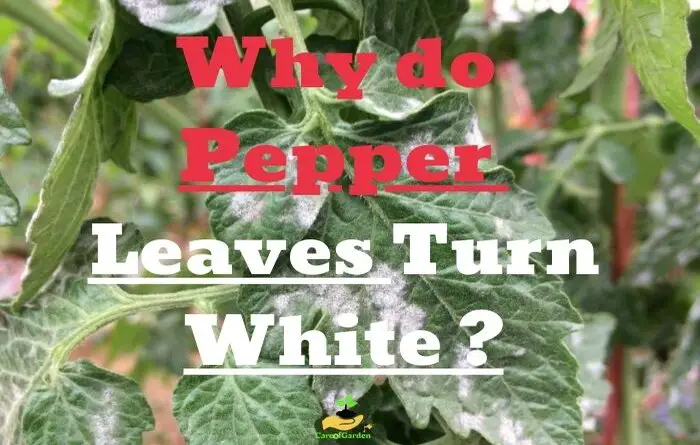Why do Pepper Leaves Turn White? (5 Causes And Solutions)
In today’s article we are going to try to find out the reasons why pepper leaves turn white. During growth and development, the culture suffers from diseases that lead to the appearance of white spots on the leaves.
The causes are either due to infection with a viral, fungal or bacterial infection. Let’s see why they occur and how to solve them.
The main cause of why pepper plant leaves turn white is a disease called powdery mildew. Powdery mildew is a fungal disease that occurs during dry weather, usually in May. It causes white spots on pepper leaves and stems. The plants mainly affected are vegetables such as, peppers, beets, carrots and tomatoes.
| Why do Pepper Plant Leaves Turn White | Symptoms |
|---|---|
| 1. Temperatures changes | Sunburns manifested by white dots on the leaves. |
| 2. Excess or lack of water | Pale white dry spots on the leaf. |
| 3. Nutrients deficiency | Whitening of the upper leaves or young leaves. |
| 4. Powdery mildew | White spots on the underside of the leaves. |
| 5. White mold | White spots on the steam and leaves. |
Causes of Pepper Leaves Turning White
1. Temperatures changes
One of the most common reason why the pepper leaves turn white is low air temperatures, or sudden changes in day and night temperatures, as well as drafts. This is due to a lack of oxygen. Not heat, not direct sunlight, but stuffiness does not allow the production of green pigment and disrupts the production of oxygen by the pepper plant.
Pepper is a warm and photophilous plant (grows best in strong light). It does not tolerate temperature extremes, extreme cold, direct sunlight and drying out. Pepper is the plant that will accustom any gardener to his regimen.
If the pepper leaves turn white after planting in the ground, most likely the pepper seedlings were not pre-hardened for 10-14 days. The pre-hardening procedure is not to accustom pepper plants to the cold (since they are not grown in cool weather) but to adapt to direct sunlight.
How to treat Temperature Changes
- The temperature during the day is within 23-28°С, and at night it is not lower than 12°С.
- 10-12 hour daylight hours.
- The soil is light, loose, nutritious and not acidic.
- Watering with warm water in the morning or evening.
- Timely feeding and protection from pests.
Failure to comply with these conditions can lead to the fact that the leaves of the pepper turn white or even fall off.
2. Excess or lack of water
The second reason why pepper leaves turn white is excessive or insufficient watering. Peppers should be watered with warm water in the early morning or evening. Drying out as well as excess of moisture can cause lightening of the pepper leaves.
Pepper leaves turn white if pepper seedlings are watered with cold water or placed in adverse temperature conditions. When seedlings are supercooled, plants are not able to absorb enough nutrients.
As a result, the root system of peppers is not fully developed, and the upper part of the pepper takes the missing substances from the leaves growing below; as a result, they begin to lighten.
Watering pepper plants on the leaves or at the root in hot weather can cause sunburn, which is manifested by white dry spots on the leaf plate.
3. Nutrients deficiency
| Nutrients deficiency | Symptoms | Fertilizer used |
|---|---|---|
| 1. Iron deficiency | Whitening of the young leaves from the base of the pepper plant. | Use 60 ml of Iron chelates per 3 gallons of water (11 liters). |
| 2. Nitrogen deficiency | Whitening of the pepper upper leaves and yellowing of the lower leaves. | Use 30 g of Saltpeter (potassium nitrate) per 2.6 gallons of water (10 liters). |
| 3. Copper deficiency | Whitening of the leaf tips and twisting towards the center. | Use 3 1/3 tablespoons of copper sulfate in 1 gallon of water (3.7 liters) |
The lack of minerals is manifested by the whitening of the pepper leaves. In this case, regular fertilizing will help. One bush requires 0.5-1 l of fertilizer every 1-2 weeks. Before feeding, the pepper plant must be watered. Fertilizer should be applied in the morning or evening or on a cloudy day.
You can feed the pepper plant both under the roots and by spraying the leaves. We must not forget that in different periods of the growing season for peppers, different doses of minerals are required.
It is best to fertilize according to the following scheme:
- Before flowering, you need to give more nitrogen fertilizers.
- During the flowering period, focus on boron.
- During the germination period, calcium should be added under the pepper plant roots.
- In the fruiting phase, pepper needs more potassium.
4. Powdery mildew
Leaves turn white in seedlings of peppers in the presence of various viral diseases or fungal infections. Powdery mildew is a pepper disease that also causes white spots on seedlings. With the development of this disease, the veins on young pepper leaves are noticeably lighter.
As with Botrytis, the presence of this fungus is perceived by the appearance of a mycelium, in this case white, on the pepper leaves. If the attack spreads, it causes the leaves to dry out and fall off, leaving the fruits directly exposed to the sun and, therefore, susceptible to sunburn.
It develops with a relative humidity of around 50-70% and a temperature between 68-73 °F (20-25º C).
Powdery mildew can be caused by excessive fertilization with nitrogen fertilizers and calcium deficiency, combined with a high temperature and humidity in the room.
How to prevent powdery mildew in pepper leaves:
- Rejection of all fertilizers;
- Additional supply of sunlight;
- Cancellation of spraying;
- Isolation of diseased plants from healthy seedlings;
- Watering the soil after it is completely dry.
Powdery mildew detected in time can be treated with a homemade remedy. You can treat the seedlings with a solution of soap and wood ash.
From powdery mildew, you can use a soda solution for spraying: 2 tbsp. baking soda with a slide must be diluted in 2 liters of water.
There we add 1 tbsp. detergent for dishes. If desired, the detergent can be replaced with vegetable oil. We stir the composition and carry out the spraying of peppers on the leaves.
5. White Mold (Sclerotinia sclerotiorum)
Very often white mold (white rot) is the reason why the leaves of pepper seedlings turn white. The disease affects the leaves located near the root zone of the pepper. Also, over time, it appears on fruits, which is why they become softer and watery. The pathogen of white mold can be found in soil or plant debris.
With a strong whitening of the leaves of pepper bushes, white mold is sometimes the cause. With this disease, light areas first appear on the foliage. Over time, the disease completely destroys the plant.
This fungal infection appears most often in closed ground, where there is a shortage of fresh air. At a temperature of +12 +15 ° C, fungi actively multiply. And the high humidity helps them with this.
Provoking factors for the development of infection are dense planting, high humidity in the shelter, high acidity of the soil.
Symptoms of white mold (Sclerotinia):
- Rotting stems closer to the root;
- Whitening of the leaf tips;
- The pepper leaves are covered with a whitish-watery coating.
You can prevent the appearance of white rot if you plant seedlings at a great distance from each other and control the microclimate in the greenhouse.
Also it reduces the likelihood of developing the disease by reducing the amount of nitrogen supplements.
With an advanced disease, it is better to remove and burn the pepper bush, and pickle the soil with a solution of potassium permanganate or fungicidal preparations.
At the initial stage, a complex treatment is carried out:
- Cut off the infected parts.
- Treat the infected peppers with chalk powder and manganese solution.
- Treat the pepper plant with a copper-containing fungicide.
To prevent the leaves from turning white, you need to constantly monitor air humidity, remove faded leaves and step-threads.
How to prevent pepper leaves from turning white
To prevent whitening of the pepepr leaves, proper care of the vegetable crop and protection from diseases is necessary:
1.To obtain a strong plant with good immunity to fungal and bacterial infections, seedlings are transplanted to a permanent place only after the final establishment of warm weather. Seedlings should not be overgrown. For this, the pepper seeds are sown on time.
2. Seedlings are planted in a permanent place in previously prepared soil. For this, disinfection is carried out and fertilizers are applied. If necessary, dolomite flour or wood ash is additionally added to reduce the acidity of the soil. After transplanting, the pepper bushes are regularly watered. Periodically carry out loosening and make top dressing.
3. In open beds or when growing in a greenhouse, pepper plants are regularly inspected to notice signs of fungal infections or suspicious spots on the leaves in time. Then timely treatment will help save the crop.
4. When infected pepper plants are found, they are dug up and taken out of the site, trying not to infect the rest of the bushes. At the initial stage of infection, it is enough to remove the damaged leaves and treat the bush with fungicide solutions.
5. In addition, for growing strong bushes, fertilizers are regularly applied, adhere to the recommended irrigation regime, be sure to regularly loosen and clear the soil from weeds.
6. To eliminate white spots on the pepper leaves, chemical and biological fungicides are used, and the rules of vegetable crop farming are observed. If the plants are infected, treatment is started in a timely manner to save the crop. To prevent diseases, preventive treatment of plants is carried out.




